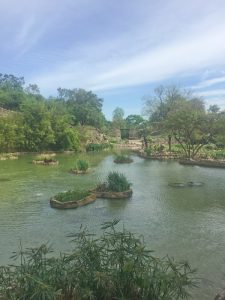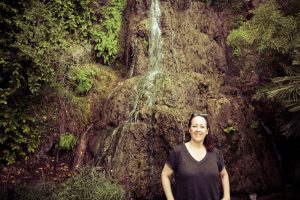Japanese Tea Garden San Antonio Texas
Sometimes the smallest of details will get the biggest acclaim.
Whenever I travel I look for tea. I want to find a unique home grown tea store to visit, review and of course purchase tea from. While searching for an upcoming trip to Texas I came across the Japanese Tea Garden. Interested, I decided to add it to the itenary.
While there was not a lot about “tea” in the garden I could only imagine tea served here. There is a small cafe which does serve tea, oddly enough. But the tea garden was much more focused on relaxation and peace then a cup of tea. Ceremonially a tea garden was a place to garden, to get down to earth and yes drink tea. It was a dedicated place to hold the tea ceremony. The tea ceremony is a very specific way of preparing and serving tea.
I did find these this explanation of tea gardens from Wikipedia:
Traditional Japanese gardens can be categorized into three types: tsukiyama (hill gardens), karesansui (dry gardens) and chaniwa gardens (tea gardens). The main purpose of a Japanese garden is to attempt to be a space that captures the natural beauties of nature.
Our world has so much to offer. At times I become overwhelmed wanting to see it all. In reality we will never see it all. A lifetime is too short to take in the vastness that our country has. The rich history continues to amaze me as I travel the country in search of what is out there. I take the time to bring what I find of interest back to you. Especially in the interest of tea. It’s a passion and a love of mine and so many others.
Later I will share the history of the Japanese Tea Garden. The reason the name changed to Chinese Sunken Garden and why the original creators of the garden were forced to leave.
The garden is actually connect to the San Antonio Zoo by a long dirt walkway. The walk way takes you through high grass and vegetation that is allowed to grow freely. it’s an incredible beautiful place. We had no idea where the path was taking us. We are adventurous, we walked and we heard noises in front of us. When we got there we smiled, wished we had more time and realized we had stumbled into the San Antonio Zoo.
When you first walk into the Japanese Tea Garden you are greeted by a ceremonial archway with a plaque. The plaque explains the history of the tea house and a worthy read. (see below)
You walk up a few stairs. You are in awe of a rock pillared pagoda before you. It’s amazing seeing all the rocks piled on top of each other making the pillars as well as the canopy of the pagoda.
You barely get a moment to take it all in. Then you look beyond the pagoda to the “sunken” gardens and you ust at a loss of words, it’s so beautiful.
A waterfall off in the distance catches your eye as you admire the beauty. It’s not even spring or summer yet. The flowers are not in bloom. Yet, this place is breathtakingly ornate and beautiful.
There are a lot of Koi fish waiting for you. As you walk over the bridges you can see the plants starting to bloom. The water lilies are being planted and life is coming to this amazing place.
There is a freshness in the air, it’s crisp. You might even think it’s filtered and most likely it is because of all the water and plants.
I could imagine the most splendid wedding here, small intimate and serene.
The pictures I am sharing are the pictures that I took while visiting. Remember, the plants had yet to bloom and things were still being prepared for spring/summer. It’s so beautiful right now as I stand in these spots taking in waterfalls, water plants, walkways, ponds and more. I can only imagine how much more amazing the gardens are in full bloom. It’s worth a trip back!
I’m glad we took the time out of our travels to visit. I’ve enjoyed sharing the pictures with you, if you get near San Antonio, please visit. They also have a lunch area that serves tea. We were too late for tea in the Jingu House Café. That will have to wait until the next trip to San Antonio.
History of the San Antonio Japanese Gardens
In 1899, the San Antonio Water Works Company, through its president, George W. Brackenridge, donated 199 acres to the City of San Antonio for a public park.
This tract comprises the largest portion of the park that today bears Brackenridge’s name. After some improvements were made, the park officially opened to the public in 1901. At that time, there was still an operating rock quarry west of the park on City-owned property. The quarry had been leased by the City to stone cutters since the mid-1800s and in 1880, Alamo Portland and Roman Cement Company (later called Alamo Cement Company) began to use the quarry. When the company needed rail lines to expand production, it purchased a new site and closed its Brackenridge Park operation in 1908.
Between the quarry and San Antonio River to the east was an 11-acre tract of land owned by Mrs. Emma Koehler, widow of Pearl Brewery owner Otto Koehler. Mrs. Koehler donated this land to the City in 1915 for a public park and its location immediately adjacent to the abandoned quarry posed a challenge for City Parks Commissioner, Ray Lambert.
Lambert ultimately came up with the idea of a lily pond which eventually became the Japanese Tea Garden.
With plans from his park engineer and no money, Lambert was able to construct the Garden. Between July 1917 and May 1918, Lambert used prison labor to shape the quarry into a complex that included walkways, stone arch bridges, an island and a Japanese pagoda.
The garden was termed the lily pond, and local residents donated bulbs to beautify the area.
The City nursery provided exotic plants and the City Public Service Company donated the lighting system. The pagoda was roofed with palm leaves from trees in City parks. When completed, Lambert had spent only $7,000. In 1919, The American City magazine reported that “the city of San Antonio has recently completed a municipal lily pond and a Japanese garden which we believe are unique.”
Lambert continued to improve the garden, and in 1920, at the base of the old cement kilns, a small village of houses were constructed, termed by the San Antonio Express as “another dream of the artist of the Lily Pool, Ray Lambert, Commissioner of Parks.”
The village was designed to be a tourist attraction for the manufacturing and sale of Mexican arts and crafts and an outdoor restaurant. It is not known how long the village operated. At the entrance to the gardens, artist Dionicio Rodriguez replicated a Japanese torii gate in his unique style of concrete construction that imitated wood.
In 1926, at the City’s invitation, Kimi Eizo Jingu, a local Japanese-American artist, moved to the garden and opened the Bamboo Room, where light lunches and tea were sold. After Mr. Jingu’s death in the late 1930s, his family continued to operate the tea garden until 1942, when they were evicted because of anti-Japanese sentiment during World War II.
A Chinese-American family operated the facility until the early 1960s, and it was known as the Chinese Sunken Garden.
In 1984, the area was rededicated as the Japanese Tea Garden in a ceremony attended by the Jingu’s children and representatives of the Japanese government.
In recognition of the Tea Garden’s origin as a rock quarry that played a prominent role in the development of the cement business, as well as its later redevelopment as a garden, the site is designated as a Texas Civil Engineering Landmark, a Registered Texas Historic Landmark, and is listed on the National Register of Historic Places.
The garden underwent a renovation beginning in May 2007 in which the ponds and waterfall were repaired, along with adding a recirculation system to provide a safe habitat for new Koi and aquatic plants. This phase, which cost $1,587,470, was a public-private partnership with the City of San Antonio, the San Antonio Parks Foundation and the Friends of the Parks.
A grand reopening ceremony was held on March 8, 2008, which was attended by the Lambert family, descendents of Park Commissioner Ray Lambert, as well as numerous members of the Jingu family, including Mabel Jingu Enkoji, who was born in the Jingu House and lived at the garden as a child.
The San Antonio Parks Foundation contributed $100,000 toward the Master Plan for the Garden, as well as $800,000 toward the restoration of the ponds and waterfall. The Foundation continues to raise funds for ongoing revitalization of the Japanese Tea Garden.
Taken from: San Antonio Parks and Rec.
Conclusion
There is a lot to take in and the walk around the garden is relaxing and peaceful. I’d not miss the opportunity to visit. The fact that I was not there while in full bloom only means the garden takes on a whole new “awe” once in bloom.
In case you want to take a super deep look. Follow THIS LINK to an indepth article on the future plans of the San Antonio Tea Gardens. It’s a lot to take in. It shows you the development up to the point we now see it and the future plans of what they want to create.
There must have been a mexican village close by. I did not see it, but the plans show it and it’s restructuring plans.
Oh, I am going back. The array of flowers the brightness of the colors against the rich green background. I can’t wait.








